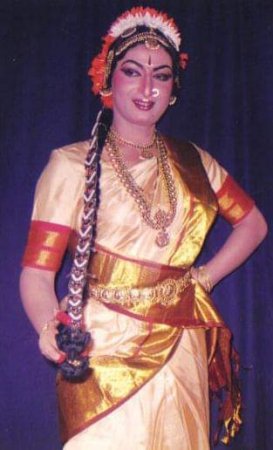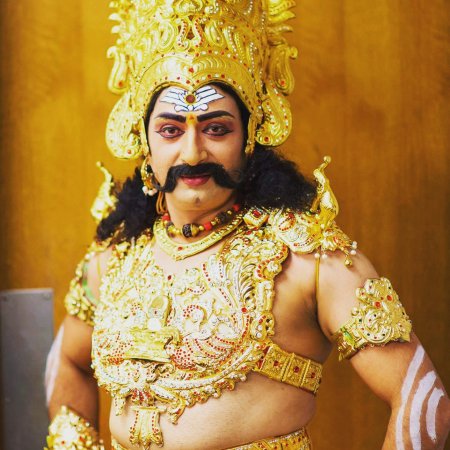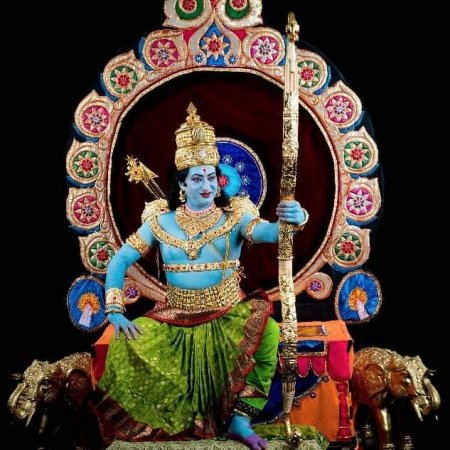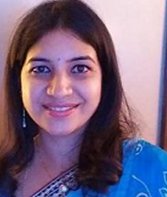 |
  |
 |
  |
Vedantam Raghava: A dancer personified - Aparna Dhulipalla e-mail: aparna.dhulipalla@gmail.com Photos courtesy: Vedantam Raghava June 4, 2020 Who is a dancer? Is dancing gracefully to the rhythm with appropriate abhinaya enough for one to be called a dancer? Maybe in today's parlance. The various treatises on dance, apart from the physical attributes, define the qualities of a dancer as a person who is learned, who speaks sweetly, is eloquent, confident, of sweet voice, well versed in geeta - vaadya and above all learned in shastras / treatises on arts. Abhinaya Darpana of Nandikeswara defines these qualities of a Nata / Nartaka (actor / dancer). One may think that such people can only be found in theory or in textbook definitions, but one would be surprised to know that there are living examples of "dancers" who possess the defined qualities. This writer was fortunate to meet, interact and know about one such versatile Kuchipudi exponent Vedantam Venkata Rama Raghavayya, popularly known as Vedantam Raghava. Raghava hails from the Kuchipudi village of Krishna District in Andhra Pradesh. He is the elder child of Vedantam Rattaiah Sarma and Rajyalakshmi, belonging to the 'Vedantam' family - one of the hereditary Brahmin families of the Kuchipudi village. Naturally, Raghava started learning dance at a very tender age, initially from Chinta Ramamurthy at Annamayya Kalaapeetam, a school started by Vedantam Satyanarayana Sarma in his house. He continued his learning under the tutelage of his father, the illustrious Vedantam Rattaiah Sarma and then under Gurus Vedantam Satyanarayana Sarma, Pasumarthy Rattaiah Sarma, Chinta Ramanatham, Pasumarthi Venugopala Krishna Sarma, Vempati Pedda Satyam, Vempati Chinna Satyam and Pasumarthy Ramalinga Sastry. All his learning in the village followed a tradition akin to gurukula system. Growing up in Kuchipudi village during the transition period of Kuchipudi from 'traditional /old style' to the new 'Vempati style' was a blessing in disguise for Raghava. He reckons that his batch was probably the last one to learn the traditional style during 1982-84. Despite all the struggles, Raghava could master both these banis. He could strike a fine balance between them and the outcome is the confluence of both the banis, representing Kuchipudi at its best and closest to its roots.  Vedantam Raghava  Raghava as Satyabhama Raghava holds a Bachelors and a Masters Degree in Dance (Kuchipudi) from Sri Potti Sreeramulu Telugu University, Hyderabad. Though his training in Kuchipudi village had already equipped him with robust understanding in Telugu, Sanskrit, music, Tala Sastram and technique, Raghava feels that the University courses aided him to master the theoretical aspects in a more structured way. Undoubtedly, his thirst for knowledge motivated him to gain a deeper understanding of both theory and practical aspects of the dance form. It is interesting to know that Raghava is also adept at stage craft. During one of the discussions, he recollects how his father used to take care of the ancestral ornaments, crowns and other accessories made from a specific light weight wood punugachakka. His father also used to make new ones when needed, and Raghava and his brother Venku learnt from their father while assisting him. Multi-talented that he is, even today, Raghava designs and makes stage properties for his productions. During his performing years in India, Raghava has worked with several generations of artistes - from Padma Bhushans to young and upcoming. With a strong Yakshagana background, he is an expert in portrayal of both male and female (female impersonation) characters. While staying in Hyderabad, Raghava was a part of Sobha Naidu's dance dramas and portrayed various roles which won him many accolades. Considering all the characters he portrayed, although every character/role presents its own challenges, the Hiranyakasyapa from Prahlada Yakshaganam is his all-time favorite, both in character and play. He remarks that it is highly gratifying to portray such a challenging character as it provides lot of scope for an artiste to show various shades - as a king, a husband, a friend, an enemy and a loving father. This is just one example that provides one with a peek into his personality, talent, and confidence in portraying demanding roles with great Úlan and adroitness.  Raghava as Hiranyakasyapa Raghava's personality is evident in all aspects of his teaching and choreography. He took to choreography and teaching at a young age of 15, and continues till date. As he was getting into more of his choreographic works in India, he shifted to the United States in mid 90s. He reckons that it was initially a disheartening experience on the artistic pursuit and his career. After a gap of few years, he started accepting students and began teaching in the US in 2002. Once he started teaching, the challenges Raghava faced provided impetus and became a catalyst to fuel his creativity. He says that, "Unlike the situation in India, most of the Indian kids in the US are exposed to Indian music, sloka recitation and chanting, painting and several other art forms. Most of the kids who come to learn dance would already be introduced to Carnatic music and are aware of most of the compositions of Tyagaraja, Annamayya, Ramadasu and the like, and if my dance compositions are also on the same songs, the kids will not have anything new to learn." Thus, his personal inclination and the challenges posed shaped his works in a diverse way. Throughout his journey, Raghava has been a constant seeker of knowledge and promulgates the same to his students and wider audiences through his choreographies. This is reflected in the selection of songs, usage of different talas, incorporation of gatibhedas, construction of jathis etc. in his choreographies, of which a few examples have been discussed below. His choreographies encompass not only Keertanas, Kritis, Padams and Javalis, but also Stutis, Stotrams and Ashtakams, compositions with a scope to include dramatization from Indian mythology and also quite a few works of Dr. Mangalampalli Balamuralikrishna. Raghava prefers Dr. Balamuralikrishna's compositions as he opines that "they are easy to understand, correct scripts without any aksharadoshas are available, and bring freshness and innovation." Dr. Balamuralikrishna has brought in so many innovations in Carnatic music in ragas and talas. This innovation may have resonated with Raghava's nature and has unknowingly attracted his attention to Dr. Balamuralikrishna's works. Sahityam or the literature is the first and foremost parameter that inspires Raghava to choreograph a new composition. Raghava always gives a special status/treatment to the invocatory songs and he personally treats Vinayaka stuti with great reverence. He says, "The opening of a performance must be grand and impressive and there is a special structure given in Kuchipudi repertoire for dance composition on Vinayaka and hence it should not be treated like a normal keertana". He uses certain specific syllables like Gam, Dinnatom, Tatakum, Daddodimda in the jathis for these songs. In the choreography of "Vande Anisham Aham", written by Mysore Vasudevacharya, set to Hamsanandi ragam and adi talam, Raghava brings in 'Mukhi talam' in one of the jathis. The Mukhi talam was invented by Dr. M. Balamuralikrishna, based on the concept of Sasabda and Nisabda kriyas. For a simpler understanding, this concept is close to Gatibhedam. In this particular jathi, Raghava uses it in a Tisra Jaati Jhamper Talam with Sasabda kriyas in khanda gati and Nisabda kriyas in chaturasragati. He goes a step further and at the end of the jathi he augments lyrics with his own writing and effortlessly fits them into the jathi pattern. In yet another invocatory song on Lord Vinayaka, "Gajananayutam Ganeswaram", a Muthuswami Dikshitar composition set to ragam Chakravakam, Raghava draws inspiration from "Melavimpu". He feels that there are so many precious jewels in the treasure box of Kuchipudi which are not being used at all. Drawing the inspiration from "Andaalu" and "Melavimpu", Raghava produced a nritta piece as part of the invocatory song. Phrases like 'Dim digitaka doddodimda dimtakitataka doddodimda' are used in different gathi patterns and voice modulations. His strong knowledge of the tala system is clearly witnessed in the construction of the jathis in various tala and gati combinations. He believes that a jathi should elevate the song and must act as a lead to the song. And, it must be aligned to the rasa of the song. Hence the variety in the syllables, patterns, and voice modulation in rendering of the jathis is seen. In the composition for the song in "Omkaara karini", one can see the creative usage of traditional syllables like "Kirrata, Deku, Nagam, Degam". The second stanza of this song starts with "Humkaara maatra". Based on his principle of jathi leading into the song and jathi to be in line with the song and mood, Raghava uses syllables like "Humtaka Namtaka Humata Namtataka" in the jathi preceding the second stanza. Not just in jathi construction, Raghava's creativity is witnessed in all aspects of his works. He pens lyrics for his songs and slokas. Space coverage is something that one should learn from him. The movement patterns, which are a blend of both traditional and Vempati styles, are created to utilize the entire space on the stage. And Raghava, not only ensures this for nritta based items, but also for abhinaya based items like padams and javalis. In one of his works, "Gaanalola nee leela", a composition of Dr. Balamuralikrishna, for the phrase "Saptagirulameeda", ample time was taken to establish the seven hills of Tirumala in order (where the music depicts the Saptaswaras S,R,G,M,P,D,N), covering the stage. For an audience, this gives an image or a vision of the seven hills on the stage. A similar approach is seen in his choreography of "Kali Stuti" during the verse "Yaa devi sarva bhuteshu" where each incarnation of the goddess is brought on to the stage, using the breadth and depth of the entire stage one end to other. This aspect further leads into establishing and dramatizing a character on stage concept, which is yet another quintessential quality of Kuchipudi. And needless to say, Raghava gives great attention to detail to the aspect of dramatization. He says that he follows Mahakavi Kalidasa's philosophy in terms of "Nataka Dharmam, Bhaava Prakatana and Rasa Prakatana". He says an artiste should strive to bring out Kavi hrudayam which is the essence of any composition. An excellent work which exhibits his mastery on dramatization can be seen in his choreography of Aadhyaatma Ramayana Keertana, which narrates the discussion between Mareecha and Ravana, Ravana's contemplation, his plan of asking Mareecha to lure Rama into forest in the disguise of a deer and the story further. It was initially choreographed by Raghava's father Vedantam Rattaiah Sarma and reworked by Raghava. He tries to balance the Chaturvidhaabhinayas, to stay connected to the roots of Kuchipudi and ensures to include at least one traditional piece from Bhamakalapam or Usha Parinayam including the Vaachikaabhinayam in the Rangapravesams of his disciples. Raghava explains that Vaachikaabhinayam is not just rendered in the form of text but also depicted in the form of presentation in Kuchipudi. His knowledge of Sastras is so expansive that he could incorporate hasta mudras from Agama Sastras in his choreographic works on Goddess Kali and Gayatri Maata. At the same time, hand gestures close to loka dharmi are also used in certain abhinaya pieces.  Raghava as Rama in Ramakathasaram Another distinctive composition in Kuchipudi repertoire is Tarangam, which is performed for the compositions of Narayana Teertha. But Raghava doesn't settle to what is done in general or what is common. He envisioned five aspects of Lord Shiva -as Rudra, as the dance partner of Parvati, as the Cosmic Dancer, as Dakshinamoorthy, as the protector of devotees, combining nrittam, nrityam and natyam interspersed as waves. This vision of Raghava was penned by Vedantam Ramalinga Sastry and music composed by DSV Sastry. The natya element covers the stories of Bhakta Markandeya, Tripura Samharana, Hymavati's wedding to Shiva, Ardhanareeswara and story of Gajasura. Raghava also experimented with jathi patterns in this Shiva Leela Tarangini introducing the concept of 'double jathis', which in essence is a short jathi paired instantly with a long jathi and rendered at a stretch. This exceptional composition runs for almost 45 to 50 minutes, including the dance on the brass plate, making it the longest Tarangam so far in Kuchipudi repertoire. These are only a few of his works. Raghava is firmly convinced that, "Common man is the goal and whatever is done through dance must be in such a way that its beauty captivates the scholars and the commoners alike. There must be some takeaway for everyone." Raghava brings in a parlance between watching a movie and a Kuchipudi dance recital. He says, "Just like how a movie has something (various moods and shades, a story, a wow factor) for everyone, a common man should feel much more elated after watching a dance performance when compared to watching a movie". He opines that cinema has its roots in natya. Like many other Kuchipudi hereditary artistes, the cinema had its impact on Raghava too. He recalls that in his childhood, he and a few of his friends used to enact movie scenes from the old mythological Telugu movies and portray the movie characters during their play time. A keen eye and impeccable observation aids a true artiste in learning, and Raghava imbibed this from his childhood. For instance, he draws inspiration from a fight scene in a commercial Telugu movie Khaleja (2010). Raghava mentions that in that fight scene, a character is seen reciting some stotras in the background which caught his attention. His curiosity led him to the discovery of Patanjali stotram and then its choreography. To give yet another example, in one of his choreographies Omkara kaarini, a song on goddess Parvati, he draws inspiration from the opening scenes of an old Telugu movie Rahasyam (1967), where certain verses are chanted in praise of the goddess. Raghava intelligently blends it into the opening of the song Omkara kaarini. As Mahakavi Sri Sri wrote in his poetry, "Thalupugollem, Harathipallem, Gurrapukallem... Kadedhi kavitha kanarham" It means that nothing is inept of being subject for poetry. Akin to this, the entire universe is an inspiration to Raghava. In spite of having choreographed matchless and exclusive compositions, Raghava very modestly and humbly says that he is just trying to put together the learnings imbibed from his Gurus. He says choreography is a big word and what he does is just to put few things together. He strongly believes that Guru Vempati Chinna Satyam has experimented and invented so much that there is not much left for any of the artistes to innovate further. Raghava further adds that his works are based on whatever little understanding and insights he gained by learning under such illustrious legends and his keen observation of so many legends since his childhood. Through his institute Vedantam Kalakshetram in Houston, Texas, Raghava endeavors to teach and train the next generation of artistes in his unique way. He is a passionate teacher who tries to give the best to his disciples, and his never ending quest to try something newfangled and distinct (which would add value to the existing tradition) everytime an opportunity presents itself is his lifeline. He curated Natya Sabha, which conducts and organizes programs periodically. The beginners recite slokas and chant verses, some sing and a few other senior students dance. Natya Sabha is a platform for his students to present their learnings and get an exposure. He is disappointed at the dearth of performing opportunities even in the United States in recent times. Looking at the sponsorship for sports, movies and celebrities, even from the Indian Associations established in the United States, Raghava feels unhappy that there is hardly any platform and sponsorship provided for traditional arts and artistes. He also feels disheartened with mediocrity found everywhere, and which seems to be the accepted norm. Then again, he is very positive and optimistic that things will change, and the form will regain its glory - for that one must be sincere to one's work and carry it out with conviction. He says that these traditional arts are like a river. It's ever flowing with fresh waters replacing the old. One must see Raghava's works to experience them. Watching his choreographies is feeling the "free spirit". The movements are fluid and vibrant and the seamless integration of old and new styles, with a touch of Raghava's creative brilliance, is a captivating experience for the artistes and the audience. He is a master creator with a panache for enthralling a common man.  Aparna Dhulipalla is a Kuchipudi dancer and research scholar from Hyderabad. She is an 'A Grade' artiste of Doordarshan and holds Masters degree in Business Administration and Performing Arts (Kuchipudi). She is currently pursuing her Ph.D in Dance from University of Hyderabad under the guidance of Prof. Anuradha (Jonnalagadda) Tadakamalla. Post your comments Please provide your name and email id along with your comment. All appropriate comments posted with name and email id in the blog will also be featured in the site. |